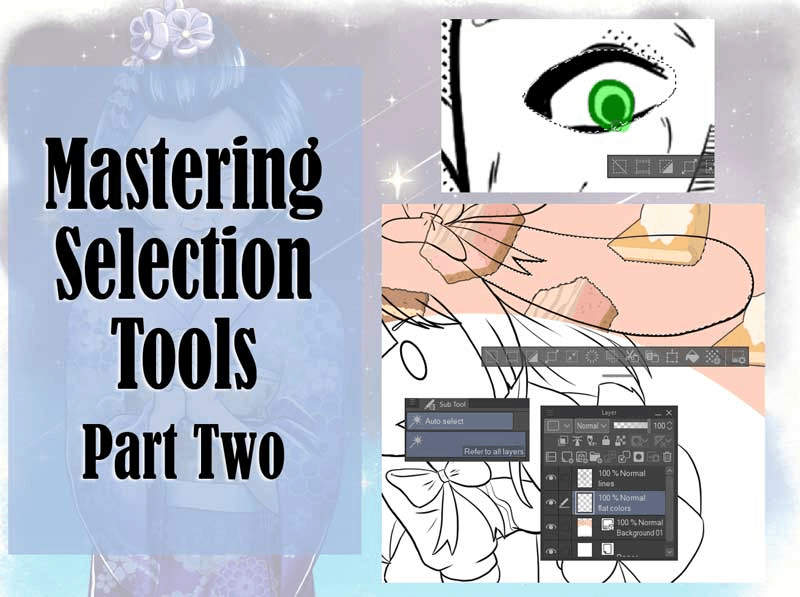Color correction in Clip Studio Paint!
Hi! Today I’m going to show you how i use the color correction layers to make my paintings more interesting ! I don’t use all of them most of the time so i will show you the ones I’m the most familiar with and that are the most useful to me!
Brightness/Contrast.
First of all , here is where you can find all the Color Correction layers!:
Click Edit > Tonal correction(D)>
You can also find them on the layer window > New correction layer(J)>
So I use brightness and contrast When i want to make my values look better . For exemple if my painting is too dark can make it brighter and vice versa.
This is the original painting and I’ll modify the values with the brightness and contrast to make it look like this!
The difference isn’t too drastic because i usually use that tool when I’m polishing my painting at the end !
Hue/Saturation/Luminosity
This is one of the color correction layer I use very frequently, it allows you to change the global hue , saturation and luminosity of your painting!
For exemple below is another painting i made , but I think the colors look to flat so I’m gonna change them towards a more pink/purple hue!
I amplified the saturation and put the hue cursor to the left (to give it a more purple color) and turned down the luminosity a bit!
I often use this tool when I’m unsure about a new character’s color theme , i change the hue to see what hair color would fit the character more for exemple!
I did the same thing with the previous painting I showed. It’s up to you to play with the cursors until you find a combination you like!
Posterization
Next is posterization .
It allows you to reduce the colors of you painting.
The lower the number the lower colors you will have!
And the higher the number the more colors you will get !
I don’t usually use this but it’s very neat if you want to give your painting a GIF-like effect or to stylize it a little bit more.
Reverse gradient
So Reverse gradient simply allows you to reverse the colors of the painting! You can use it alone or can combine it with layer modes! ( in fact you can combine every color correction layer with layer modes)
Don’t forget that you can use selections and it will only affect the selection area!
This is what it does , then I’m going to combine it with some layer modes!
Reverse Gradient + Hue mode=
Reverse gradient + Overlay mode=
Reverse Gradient + Lighten mode=
Basically you can experience with all the layer modes to see what you like better!
Also Don’t forget that it won’t affect your painting layer since a color correction layer automatically creates a new layer with a layer mask on top of the painting layer!
Level correction and Tone curve
Im gonna put these two together because form what I’ve seen they kind of do the same thing.
So here is the original painting:
So the level correction allows you to manipulate certain hues( red , blue , green) to give your painting a more cool or warm tone. Or you can manipulate them all at the same time.
And the tone curve allows you to do the same thing as the level correction but in a more drastic way!
I guess this would be useful when doing photo-bashing or working with photography!
Color balance
This is a tool i also use very often! It’s similar to the Hue/saturation/luminosity tool but it is more precise as it allows you to manipulate multiple hues , the midtone , shadows and highlights! It is very useful when you’re trying to give your painting a specific vibe!
Im re-using the paintings earlier and as you see I’ve changed the whole color theme of the drawing , now it looks like it was taken on an old camera or something.
See the difference? Now the atmosphere looks way cooler than before. I really like this tool mainly because the afterwards looks really natural!
Gradient Map
Gradient map might just be my favorite~
You can change the colors of a painting with a gradient you either downloaded from the assets or that you made yourself (you can also modify the gradients you downloaded)
So here’s the original painting again :
And boom! Isn’t it amazing~ it completely changes the way your painting looks originally by giving it a brand new color theme!
You can also combine it with a layer mode to make it suit your preferences :
Gradient + Hue mode =
Gradient + Hue mode =
And that’s it ! I hope this tutorial helped you ! If you’re interested in seeing more of my art here is my Instagram page:
See you next time !😌
























Comment